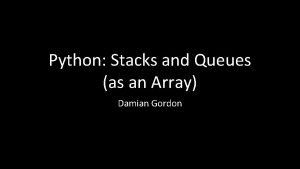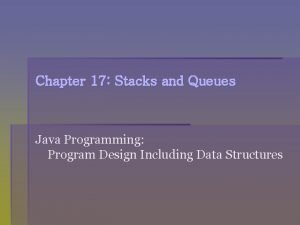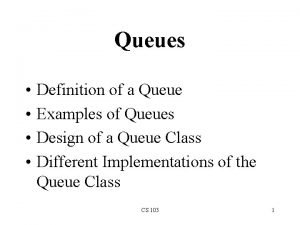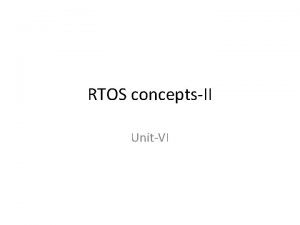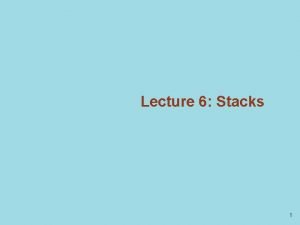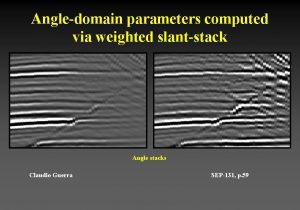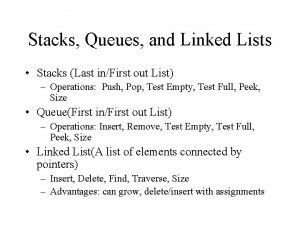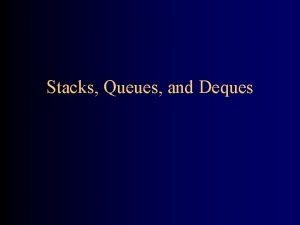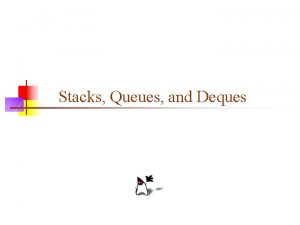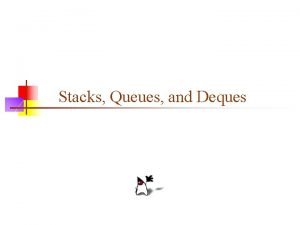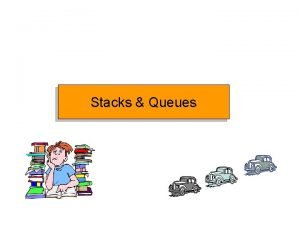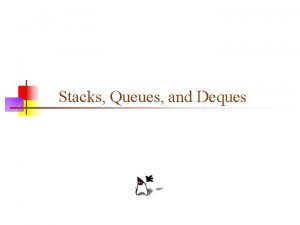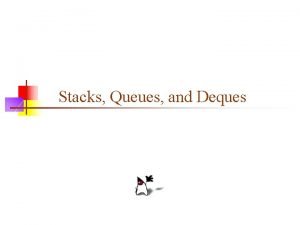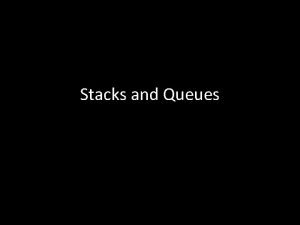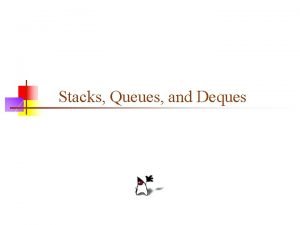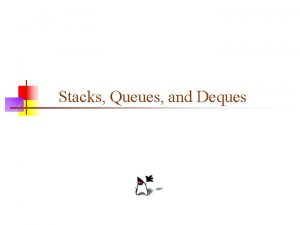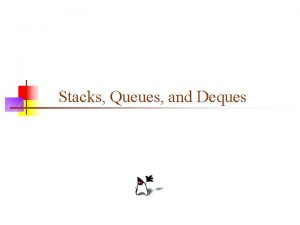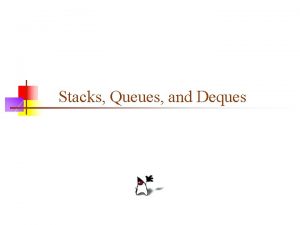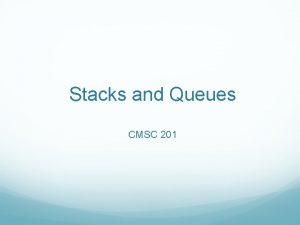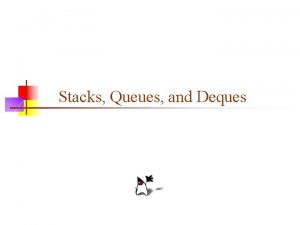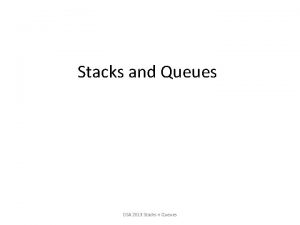Linked List Stacks Queues Linked Lists 2 Linked



























- Slides: 27

Linked List, Stacks Queues

Linked Lists 2

Linked Lists • Used for modelling lists. • Different to array. Lists • Can only add/remove at the start and end of a list.

Methods for single Linked list • public void add. First(String. Node n) • public void remove. First() • public void add. Last(String. Node node) • public void remove. Last() {

Singly Linked List node • A singly linked list is a concrete data structure consisting of a sequence of nodes • Each node stores: next – an element – a link to the next node elem A B C Linked Lists D 5

The String. Node Class for List Nodes public class String. Node { // class Attributes – data instances private String element; // The data to be stored in this node IE. A STRING private String. Node next. Node; // A link to the next node in the chain IE A // POINTER or object reference /* Constructor Creates a node with the given element and next node. */ public String. Node(String e, String. Node n) { element = e; next. Node = n; } /* Constructor Creates a node with null references to its element and next node*/ public String. Node() { this(null, null); // call the construtor above i. e. public // String. Node(String e, String. Node n) }

The String. Node Class for List Nodes public String get. Element() // Accessor method { return element; } public String. Node get. Next() // Accessor method { return next. Node; } public void set. Element(String new. Elem) // Modifier methods: { element = new. Elem; } public void set. Next(String. Node new. Next) // Modifier methods: { next. Node = new. Next; }

For any data structure/storage: Operations Location of Operation • How to add • Beginning • How to retreive • End • How to remove/delete. • Middle Linked Lists 8

Inserting at the Head of a List 1. The current list. . . head A 2. 3. Create a new node with content X node B C X Insert the node A. X Have new node point to old head B. Update head to point to new node A B C node head X Linked Lists A B C 9

String. Linked. List data members public class String. Linked. List { String. Node head = null; // start of the list String. Node tail = null; // last element in the list

Linked List – add. First method public void add. First(String. Node n) { if (n == null) // Check we have a node to add. . . return; // Set our new node to point to the head of the current list. n. set. Next(head); // Our new node 'n' will now become the head of the list head = n; // If the list was empty, make the tail point to // the new node as well if (tail == null) tail = n; } Linked Lists 11

Removing from the Head head A 1. 2. Update head to point to next node in the list B C D head A Allow garbage collector to reclaim the former first node B C D head A Linked Lists B C D 12

Linked List – remove. First method public void remove. First() { // If list is empty, we can't remove anything so leave if (head == null) return; // Move head to the next item in the list head = head. get. Next(); // If the list is empty, set the tail reference to null if (head == null) tail = null; // The original item that was at the head of the list // no longer has anything referencing it and will be // garbage collected in Java. In other programming languages // e. g. C++, you would have to delete it other wise you // would get a memory leak. }

Inserting at the Tail tail 1. The current list. . . head A 2. 3. Create a new node pointing to null node B X Insert new element A. B. Have old last node point to new node C node tail X head A B C node Update tail to point to new node tail head A Linked Lists B C X 14

Linked List – add. Last method public void add. Last(String. Node node) { // If we were not given a node, leave if (node == null) return; // If list is empty, our new node will // be the head and tail of list if (head == null) { head = node; tail = node; return; } // Make the current last node point to our new node tail. set. Next(node); // Now update the tail to be our new node tail = node; Linked Lists } 15

Removing at the Tail • Removing at the tail of a singly linked list is not efficient! • There is no constant-time way to update the tail to point to the previous node tail head Linked Lists A B C D 16

Linked List – remove. Last method • • • public void remove. Last() { if (head == null) return; // If list is empty, leave • • // If head is also the tail, the list // will be empty if (head == tail) { head = null; tail = null; return; } • • // Start at the head of the list String. Node n = head; • • • // Now look for the last item while (n. get. Next() != tail) n = n. get. Next(); • • • // n should now be pointing to the last but one // node in the list. This will be the new tail // We are going to drop the last element in the list // so make the current node's next pointer null n. set. Next(null); • • // The old tail node is now replaced with 'n'. The // old tail node has no reference and will be garbage tail = n; } Linked Lists 17

Linked List – remove. Last method public void remove. Last() { if (head == null) return; // If list is empty, leave // If head is also the tail, the list // will be empty if (head == tail) { head = null; tail = null; return; } // Start at the head of the list String. Node n = head; Linked Lists 18

Linked List – remove. Last method // Now look for the last item while (n. get. Next() != tail) n = n. get. Next(); // n should now be pointing to the last but one // node in the list. This will be the new tail // We are going to drop the last element in the list // so make the current node's next pointer null n. set. Next(null); // The old tail node is now replaced with 'n'. The // old tail node has no reference and will be garbage tail = n; } Linked Lists 19

Stack

queue

Doubly Linked List 1. A doubly linked list provides a natural implementation of the Node List 2. Nodes implement Position and store: 1. element 2. link to the previous node 3. link to the next node prev next elem node 3. Special trailer and header nodes/positions header trailer elements Lists 24

Insertion • We visualize operation insert. After(p, X), which returns position q p A B C p A q B C X p A q B Lists X C 25

Insertion Algorithm add. After(p, e): Create a new node v v. set. Element(e) v. set. Prev(p) {link v to its predecessor} v. set. Next(p. get. Next()) {link v to its successor} (p. get. Next()). set. Prev(v) {link p’s old successor to v} p. set. Next(v) {link p to its new successor, v} return v {the position for the element e} Lists 26

Deletion • We visualize remove(p), where p = last() A B C p D A B Lists C 27

Deletion Algorithm remove(p): t = p. element {a temporary variable to hold the return value} (p. get. Prev()). set. Next(p. get. Next()) {linking out p} (p. get. Next()). set. Prev(p. get. Prev()) p. set. Prev(null) {invalidating the position p} p. set. Next(null) return t Lists 28

Performance q In the linked list implementation of the List ADT, q. The space used by a list with n elements is O(n) n The space used by each position of the list is O(1) n Operations of the List ADT run in up to O(n) time Lists 29
 Java stacks and queues
Java stacks and queues Stacks and queues in python
Stacks and queues in python Java stacks and queues
Java stacks and queues Java stack exercises
Java stack exercises List adalah
List adalah In linked list the successive elements
In linked list the successive elements Difference between an array and a linked list
Difference between an array and a linked list Python plot list of lists
Python plot list of lists Empty list prolog
Empty list prolog Queue representation
Queue representation Antrian q
Antrian q Applications of priority queues
Applications of priority queues Message queues in unix
Message queues in unix Queue definition
Queue definition Adaptable priority queues
Adaptable priority queues Aganj
Aganj Queue quiz
Queue quiz Pipes in rtos
Pipes in rtos The individual flattened stacks of membrane
The individual flattened stacks of membrane Two stack pda
Two stack pda Stacks+routined
Stacks+routined Stacks internet
Stacks internet Marine terrace geology
Marine terrace geology 6 stacks
6 stacks Caves arches stacks and stumps diagram
Caves arches stacks and stumps diagram Types of stacks
Types of stacks Speedstacks com go
Speedstacks com go Angle stacks
Angle stacks

